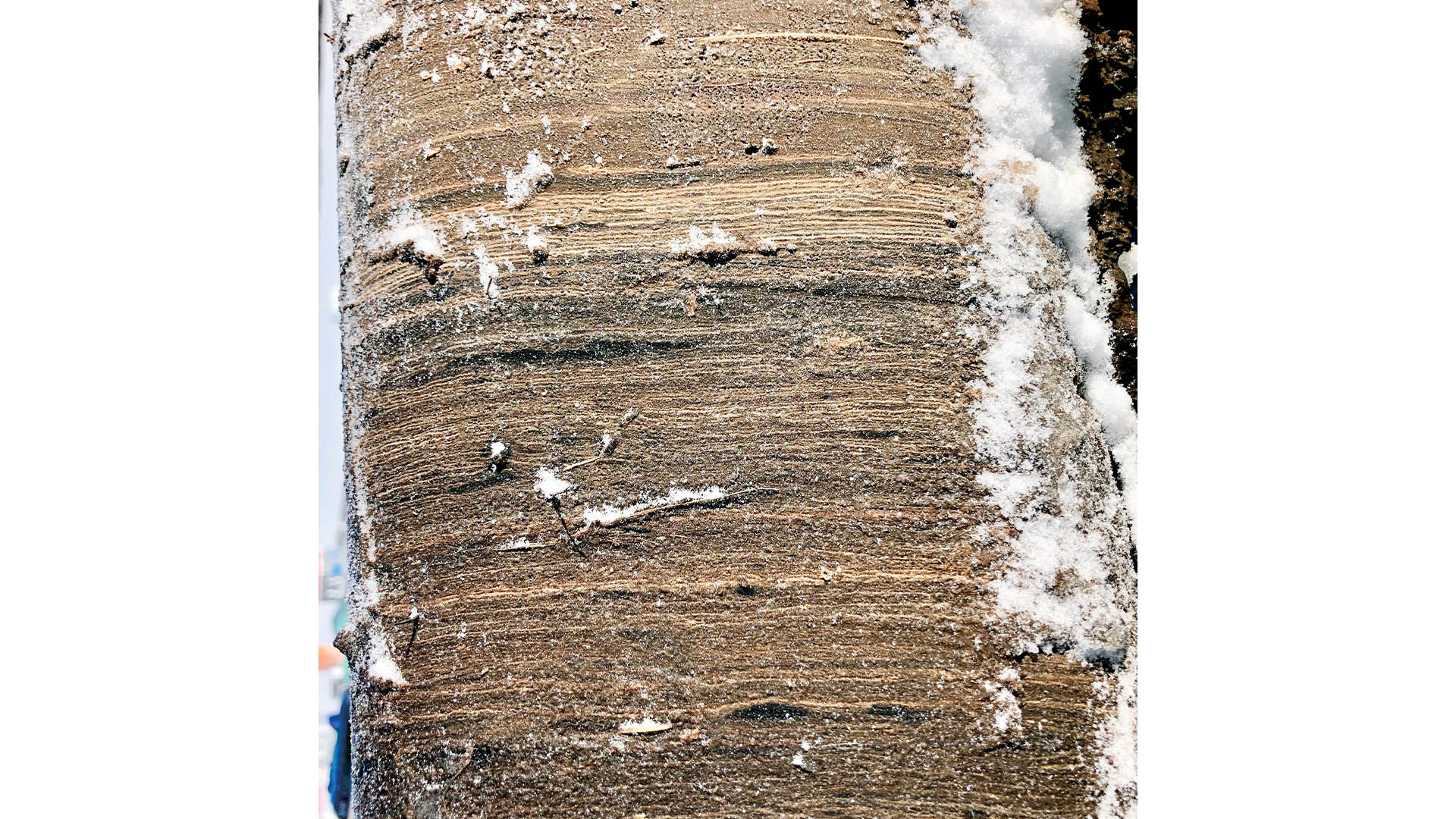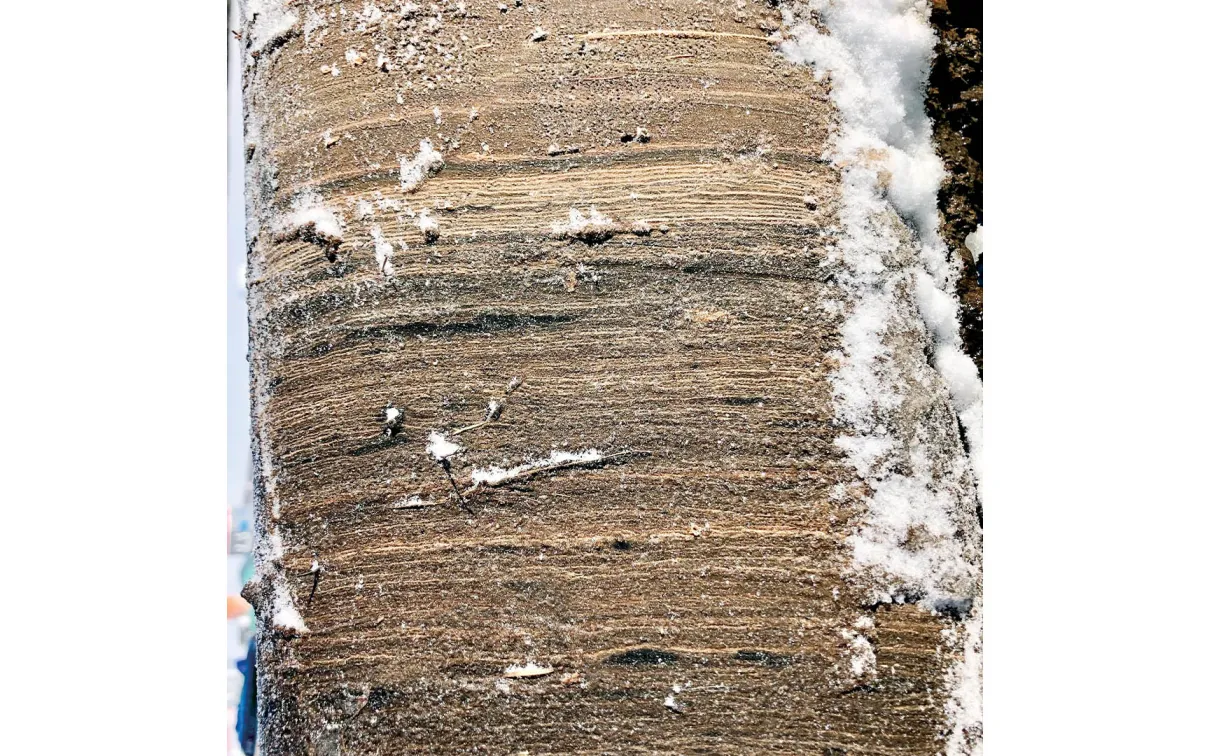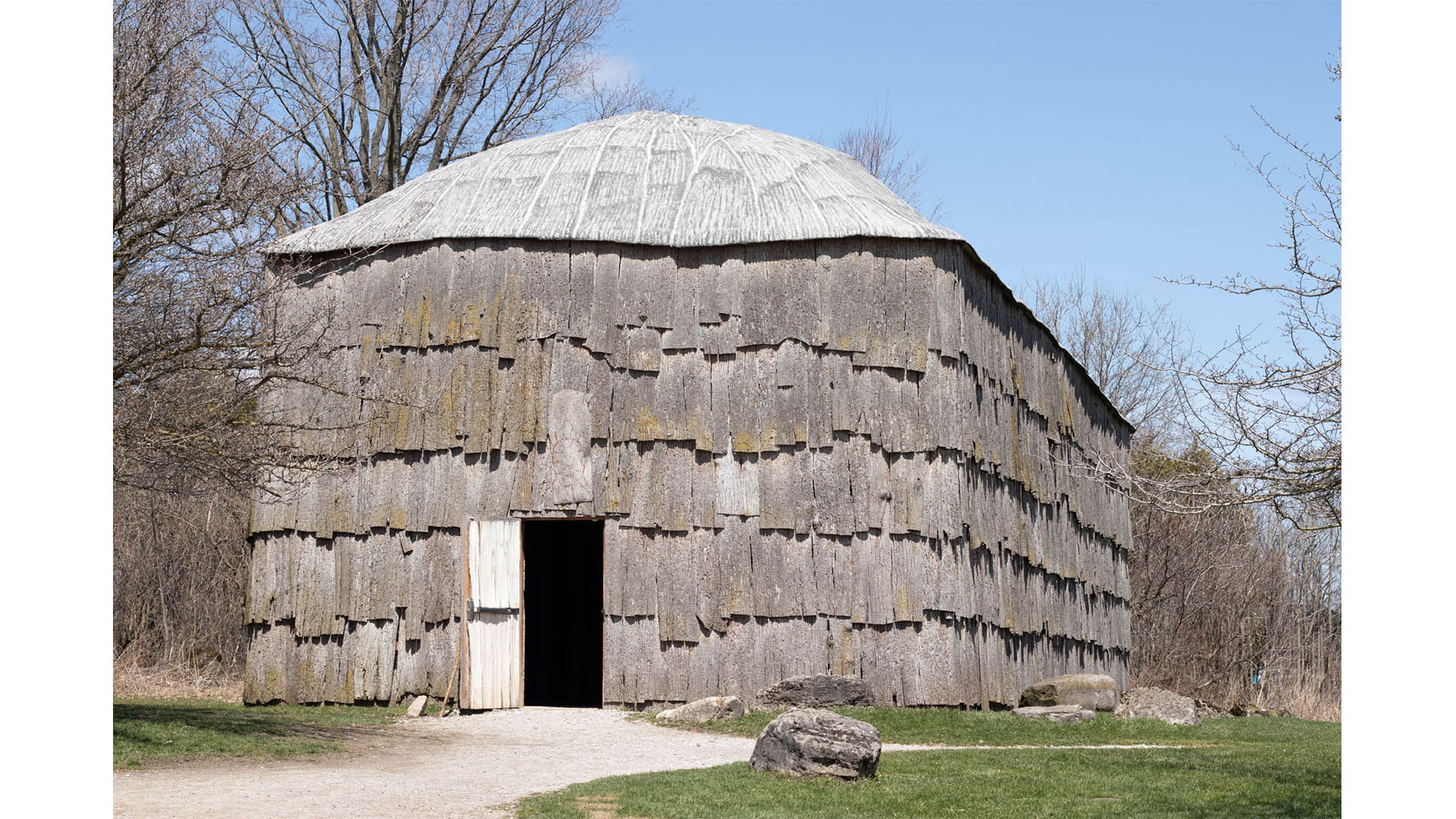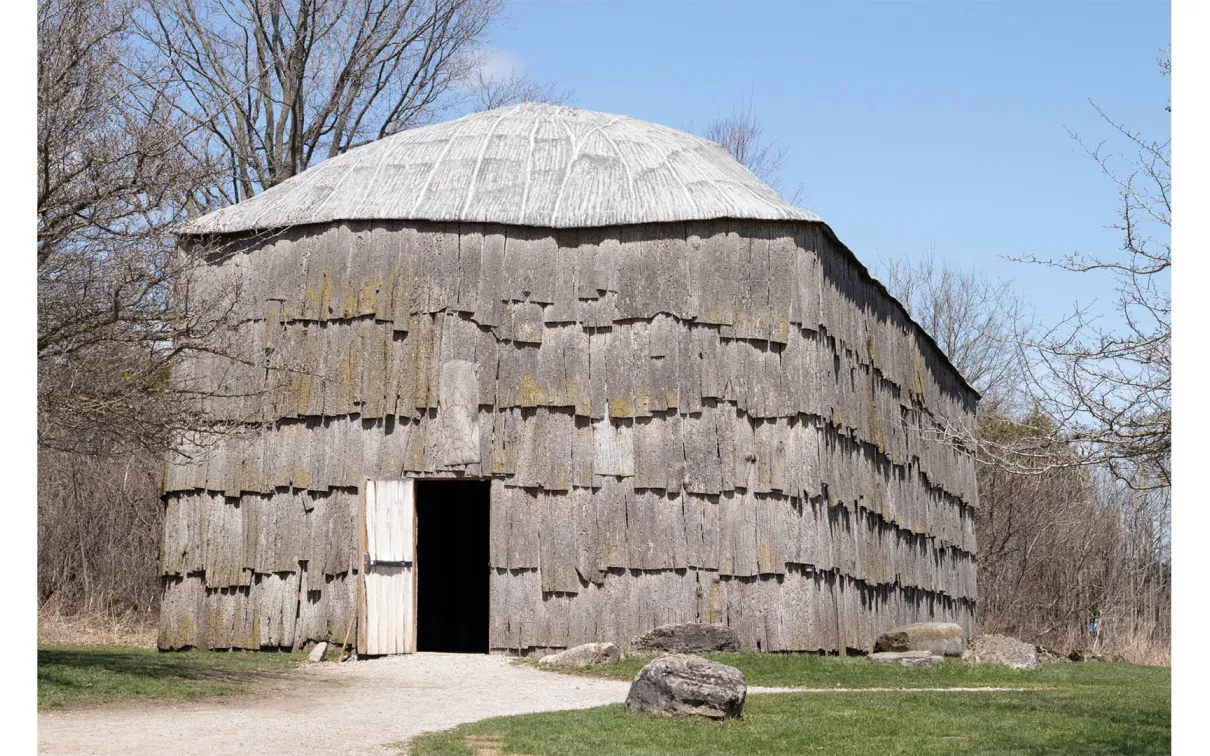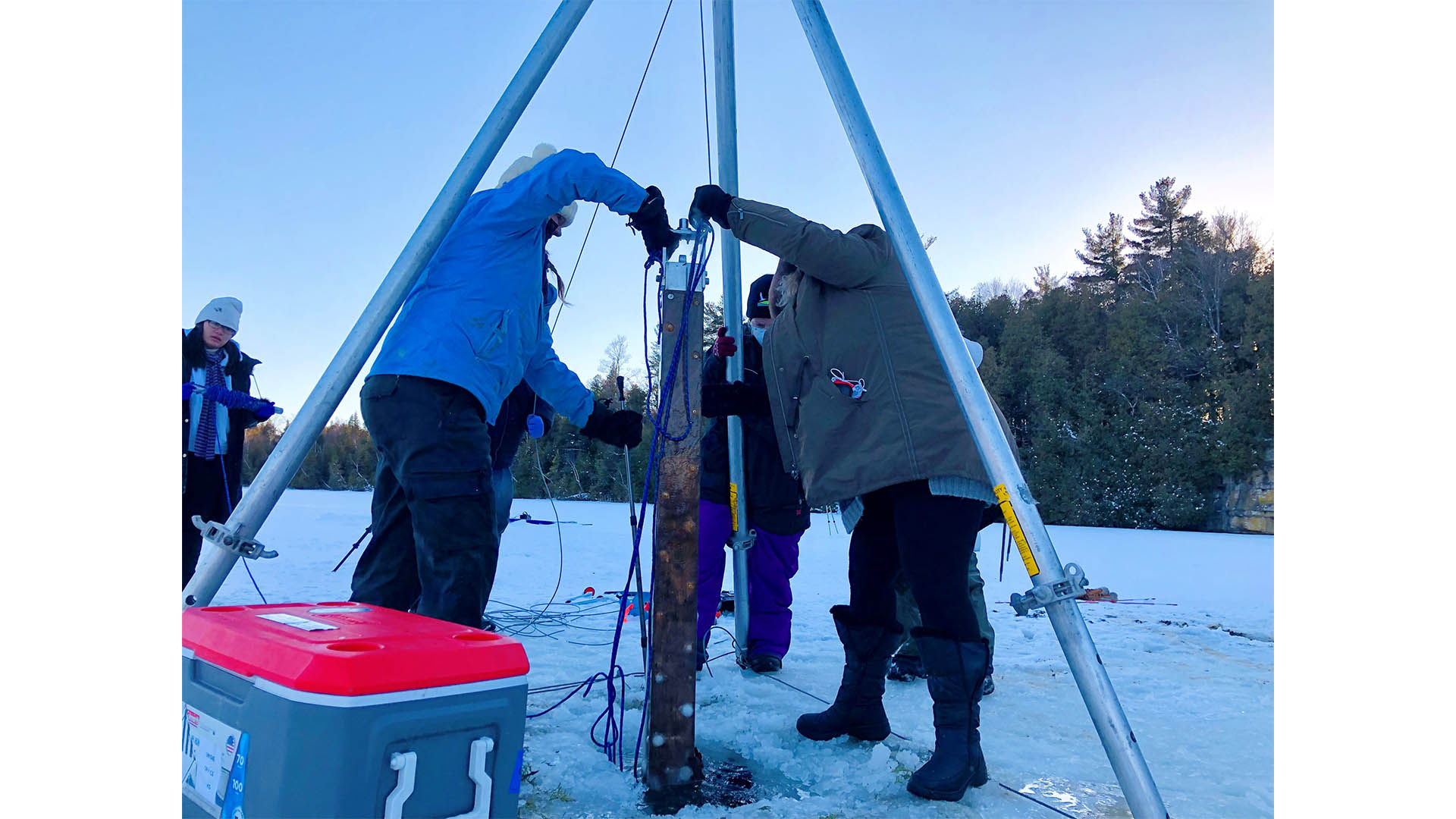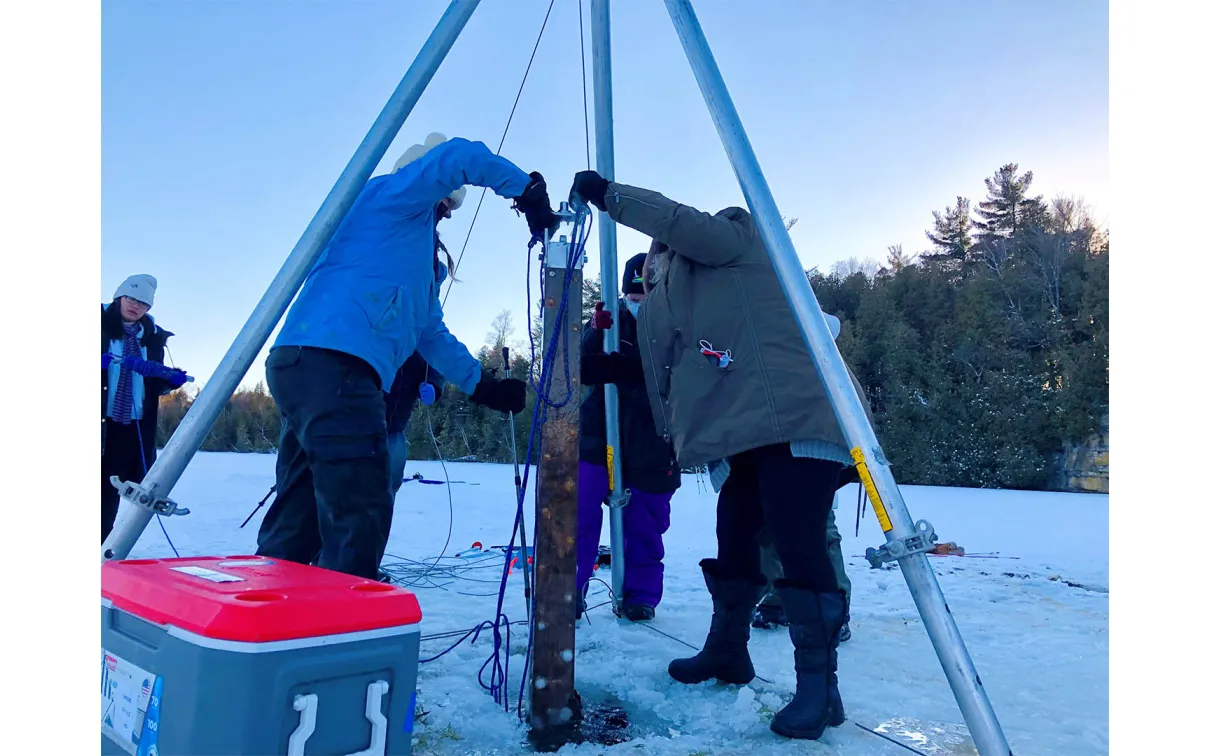The Dawn of the Anthropocene
Sediment core from Crawford Lake shows evidence of how humans have substantially altered the Earth over a short period of time. Could it define the beginning of a new epoch in our world's history?
Published
Category
Author
The coring of Crawford Lake
The day of the last coring of Crawford Lake was bitterly cold. A small crowd stood on the ice, which was almost half a metre thick. They braced against the chill as Monica Garvie, an Anishinaabe PhD candidate from northern Ontario, knelt beside a chainsaw-cut hole. She performed a ceremony and laid cedar branches on the site. “To care for the lake during an extractive process is just showing our respect and ensuring we’re maintaining a good relationship with the lake,” Garvie says. “For me, it was very meaningful to be able to be there and do ceremony.”
Then, the research team got to work, pouring a mixture of dry ice and ethanol into a big metal tube that they braced from a tripod before sending the device down into the frigid water. It headed down deep into the part of the lake where the water never mixes, allowing undisturbed layers of sediment to accumulate on the lakebed. The tube cored the sediment, fixing a cylinder of the alternating white and dark layers of each year and the story they have to tell.
Crawford Lake is deeper than it is wide, which means the lowest levels of water don’t mix with the upper layers. Decay is slow, and no large life disturbs the lake bottom. As a result, it and other such non-mixing lakes, technically known as “meromictic,” have a good record in the sediment of what’s happened since they formed, says professor John Smol of Queen’s University, an expert on analyzing lake histories.
Though it isn’t the only meromictic lake in Ontario, Crawford Lake is “of considerable interest,” he says. Its unusually detailed sediment layers—known as “varves”—show a high-resolution picture of happenings on its shores over the last 10,000 years. The record closest to the surface shows up as a light and a dark layer of sediment for almost every single year. By counting these rings, much like the rings of a tree, researchers can accurately date their findings back as far as the late 12th century. The results tell a lot about what was happening in and near the lake.
In work stretching back more than 50 years, ROM scientists have found centuries of evidence left by humans living and working around the lake. This work helped lay the ground for the lake and its shores to become an important site of learning and remembrance about the different peoples who have lived on the land, which is the traditional territory of the Wendat people. Now, these final cores will be used in determining whether Crawford Lake, with its long evidence of human activity, could be designated the “Golden Spike” that marks the beginning of a new epoch in the world’s history—one defined by humans.
The name of this possible new epoch has already entered cultural consciousness: the Anthropocene. But whether or not it will be formally declared by the body that divides and names geological time, the International Commission on Stratigraphy (ICS), is another matter. From the perspective of “deep time,” as geologic time is sometimes called, the past 2,000 years are an eyeblink, says Soren Brothers, ROM’s inaugural Allan and Helaine Shiff Curator of Climate Change. An epoch typically lasts for several million years and an Anthropogenic distinction today would imply that our human influence on the planet’s sedimentary record is irreversible.
A story of human influence
In the past, that meant changes to the rock. But “there hasn’t been enough time for cliffs of rock to form over the short period humans have substantially altered the Earth system,” Brock University micropalaeontologist Francine McCarthy writes in an upcoming book chapter. “Possible candidates that will literally define what it means to be Anthropocene [the proposed Golden Spike] include cave deposits, peat bogs, and coral reefs as well as lake and marine sediments.”
The decision will be made in the coming year by a body within the ICS, the Subcommission on Quaternary Stratigraphy. The Anthropocene Working Group will select the site that best exemplifies the change in the Earth System that accompanied the "Great Acceleration" of the mid-20th century, and they will propose the exact point in that sedimentary series to define the base/ beginning of the proposed Anthropocene epoch. Crawford Lake is among the sites being considered, because its sediments tell a clear story of local human influence for so many hundreds of years as well as the global impact of the Great Acceleration.
The cores come up from the bottom of the lake, one after another over the course of a day until there are three. The researchers use hot water to separate them from the metal tubes and yellow plastic scrapers to clean up their outsides before hauling them to shore on wooden planks. “I’ve worked with a lot of sediment cores,” Brothers says. “Usually, you take a metre-long plug of mud from the bottom of the lake, and it looks like a metre-long plug of mud.”
The clear varves of the Crawford Lake core are a different beast. “I’ve heard about these kinds of cores existing theoretically,” he says, “but they’re so rare.” The long human history clearly told by the core just makes it more appealing, he says—regardless of a possible Golden Spike designation. “It would not fundamentally change the story that this core tells,” he says.
This may be the last time the lake will be cored
Researchers have relied on the evidence offered by core after core to make their findings so far. But this may be the last time the lake will be cored, says McCarthy, who has been leading efforts related to the lake for the past half-decade and is presently a ROM research associate.
After talking with Catherine Tammaro, a Wyandot Elder and artist who became involved during consultations about the project, McCarthy says, “it became clear that our scientific aspirations to getting more sediment cores and the values of the Indigenous people about the lake as a spiritual site were different.” For Tammaro, it comes down to the Indigenous value of “right relations” with the earth. “I believe that the best way to express that would be: to not violate the earth or the natural world, to be in a relationship with the natural world responsibly, furthering sustainable lifeways,” they say.
When the local conservation authority bought Crawford Lake and its surroundings from the Crawford family in 1969, nobody knew how special the lake was. At the time, says Hassaan Basit, the current CEO of Conservation Halton, his institution was keen to prevent the 463-hectare parcel of land from being turned into quarries and foster connection with its adjacent Rattlesnake Point site. But that changed quickly after ROM curator Jock McAndrews asked to sample the lake. In the first core, his team found corn pollen in the varves as far back as the late 1200s, well before colonization. They knew right away it was evidence of Indigenous presence near the lake.
Further research established a narrative: by 1972, the researchers were confident that a village of Iroquoian people had lived on the shores of the lake, staying for decades at a time between the late 1200s and the late 1500s and cultivating maize as part of their food.
The pollen grains are probably the tiniest things
“The pollen grains are probably the tiniest things that we have in the Museum,” says Deborah Metsger, Assistant Curator of Botany at ROM. But they had a big impact on the conservation area, says Basit: by the early 1980s, work had begun on reconstruction of three longhouses on the site of their original foundations. They still stand today, populated with both artifacts and an exhibition about contemporary Indigenous art and culture. In total, evidence of 11 longhouses was found on the shores of the lake.
Metsger has also been involved with the site for a long time. In 1981, she was one of the field assistants when ROM took a core to be used as an artist reference for the model core displayed in the Museum’s evolution gallery. Back then, she says, “we cored the ice ourselves with hand augers.”
The human story that McAndrews and other researchers have found starts with the Iroquoian village, but it doesn’t end there. A few hundred years later, in the 1800s, a drop in tree pollen and the near-simultaneous introduction of ragweed pollen tells them the land around the lake was cleared, two things characteristic of European settlement.
The Great Acceleration
Then, in the late 1800s, the Crawford family bought the lake and its surroundings and began logging in earnest, setting up a sawmill on the edge of the lake to process the vast white pines in the area. All this human activity—dating back to the Iroquoian village—changed the properties of the lake and caused algae to bloom in vast mats.
But the nature of human activity’s influence on the sediment record changed in the 20th century: here, evidence of the dawn of the Nuclear Age and the Great Acceleration has also left its indelible mark. Radioactive cesium was deposited at much higher levels in the 1950s, reaching a peak in 1963 and dropping off with the signing of nuclear proliferation treaties later in the midcentury. Particulate evidence of increased fossil fuel use began to fill up the sediment record. Microplastics made their appearance.
Crawford Lake’s cores tell this whole story. One of the final three is already in a cryogenic facility at the Canadian Museum of Nature in Ottawa. Another is being held at Carleton University to be used for research. The last is now at ROM, where it marks the first acquisition by Brothers.
The February 2022 excursion marked an end, of sorts, for a process of evidence-gathering at this unusual lake. Though research on Crawford Lake’s deep secrets is far from over, it’s time for the lake itself to rest. Garvie, the PhD candidate who performed the ceremony at the lake, often finds herself in the midst of the balancing act that McCarthy is trying to perform. In her experience, Indigenous ways of knowing the world and Western scientific methods are “often incommensurable.” But as an Indigenous woman as well as someone who is studying at Queen’s University, the geologic history of lakes, she’s trying to engage with both. “For me,” she says, “the fact that Team Crawford allowed this space for the ceremony was a good sign and a move in a positive direction which normalizes different ways of being.”
Kat Eschner
Kat Eschner is a science and business journalist based in Toronto.


